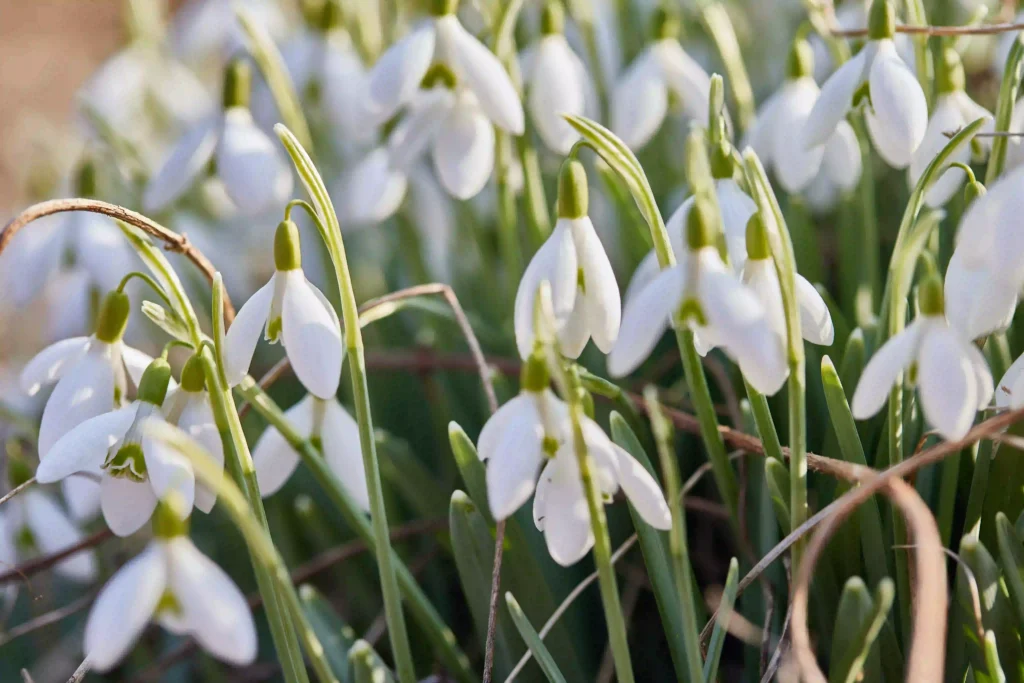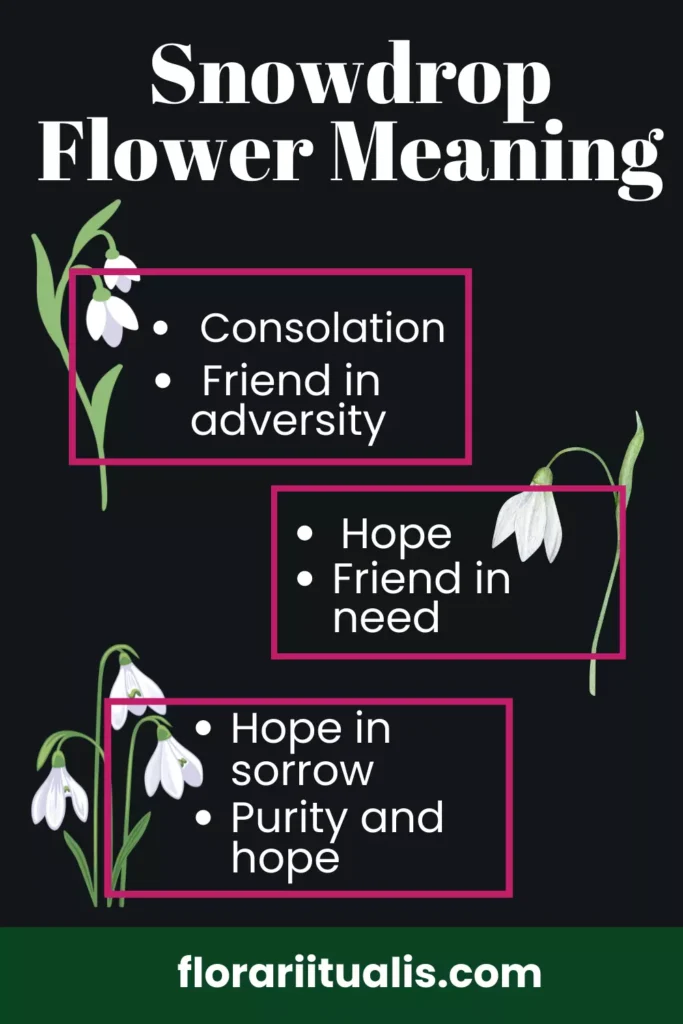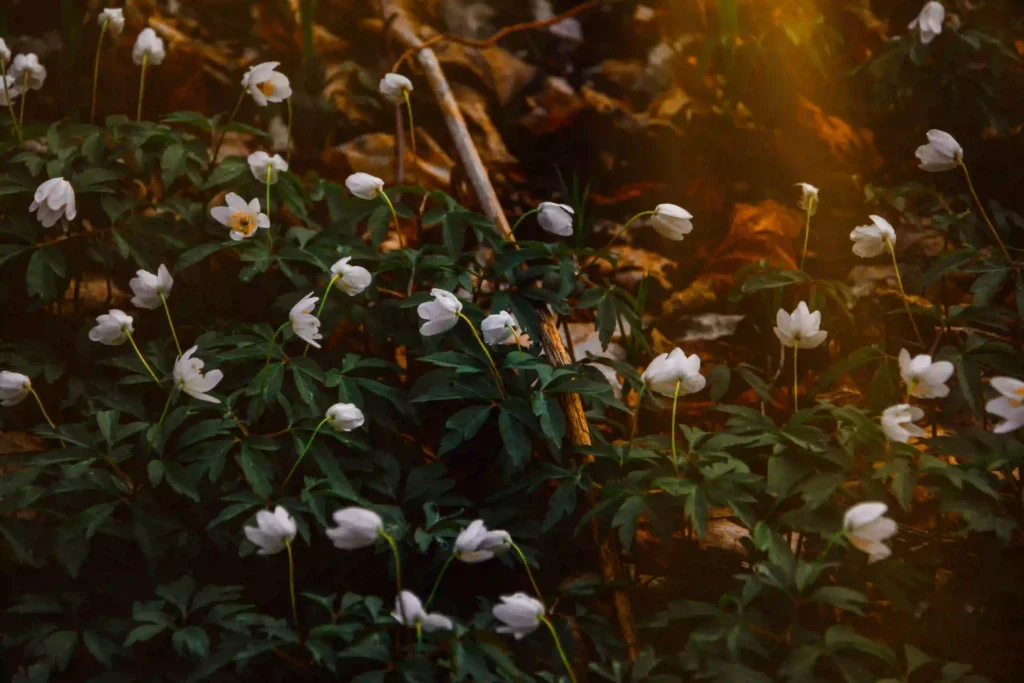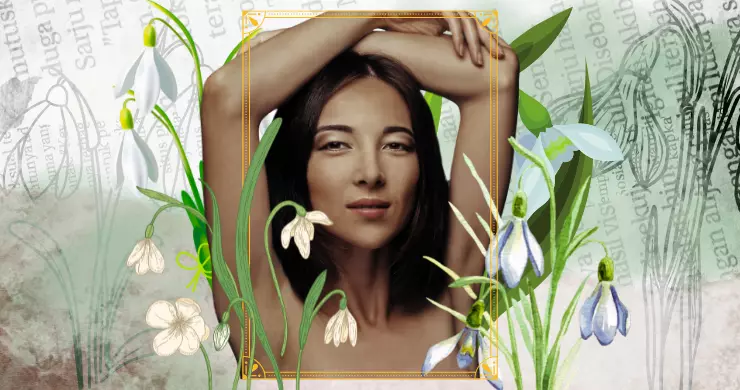The Snowdrop flower meaning has its link in Europe and its folklore. The plant has at least 75 recorded species stretching from Asia Minor to Europe.
Origins of the name “Snowdrop” is perhaps lost in time however, the closest we can get is Snödroppe in Swedish or Schneetrofen in German.
The scientific name of the flower is Galanthus Nivalis derives from the Greek word Gala which translates to milk, anthos which translates to flower and nivalis which means “of snow.”
In this blog we will explore the mythology of the Snowdrop flower meaning. We will also get into its symbolic meaning during the Victorian times. Finally, we will explore some of the beliefs surrounding the flower.
What does the Snowdrop flower symbolise?
The Snowdrop flower symbolic meaning are purity and hope, a friend in adversity or hope in sorrow. Those meanings derive from the mythology, folklore and symbolic uses of the flower.
Celtic myth behind the snowdrop flower meaning
The Snowdrop flower is often called candlemas bell and is considered the flower of candlemas day. However, the flower’s link to candlemas might go further back in time to the Celts.
In Celtic mythology, Imbolc was celebrated on the 1st of February. It was the first of four fire festivals celebrated by the ancient Celts.
The first festival celebrate the arrival of spring, the word Imbolc itself meant “in milk” which showed a new season and arrival of green pastures and increased daylight.
This shift in seasonal balance was portrayed by the myth of Cailleach and Bride. The are both considered as the duality of the same goddess light and dark in this case symbolising the victory of spring as light over the darkness of winter.
In early February, Bride breaks free of her captivity from Cailleach. She then announces her union with Agnus Og which stirs the natural world.
This Celtic celebration would then slowly shift over time. Imbolc will then become St Brigid’s Day.

Greek mythology of the Snowdrop flower
In Greek mythology the Snowdrop flower links to the story of Persephone.
When Persephone was taken into the underworld the earth turned into winter. When she came back from the underworld, snowdrops were one of the plants she brought back with her.
The plant then gave the barren landscape a breath of spring.
The idea that Snowdrops were unlucky might also derive from this myth as the flowers came from the underworld.
Biblical legend
One of the common names of the Snowdrop is “Eve’s Comforters,” the name is derived from the story of Eve.
The story tells that Eve was crying in the garden of Eden because no flower would grow there in Winter.
An Angel heard her and caught a snowflake that was passing. He breathed on it and the snowflake fell on earth as the first snowflake.
A variation of this legend exists where an Angel caught a passing snowflake, breathed on it and handed it to Eve.
When the Angel’s feet touched the ground, snowdrops began to spring from everywhere. Eve then thought those were the most beautiful flowers in Eden.

Snowdrop flower meaning during Victorian period
During Victorian times the snowdrop flower was seen as a consolation in Winter.
The flower was thought to have been introduced in Britain during the early reign of Queen Elizabeth I.
The snowdrop flower was considered as unlucky if they were brought into the house, therefore, it was meant to stay in the garden.
Victorians developed a mania for the Snowdrop flower and “Snowdrop walks.”
Other varieties of the Snowdrop flower was also introduced to Britain after the Crimean War such as the snowdrops planted on the Isle of Skye.
It was believed that the snowdrops planted there were by Highland soldiers who returned from the battlefield.
During the Victorian period the snowdrop flower meaning was expressed through its uses:
- When a friend encountered a loss then a brooch in the shape of snowdrop would be given to them.
- A small vase of Snowdrop flowers were given as a sign to uplift spirits and also give hope that happier times are on its way soon.
- If a New Year’s card featured a basket of Snowdrop then it would evoke hopeful thoughts.

Beliefs surrounding the Snowdrop flower
As previously mentioned the Snowdrops were considered as an unlucky plant to have indoors. However, in Wales it was only considered unlucky if the plant was brought indoors on St Valentine’s Day.
The result of bringing the Snowdrop indoors ranged from the milk of cows being watery to the death of someone living in the house.
Snowdrops were also considered as unlucky if it was given to a patient. This was a considered as a death sentence. In order to lessen the omen nurses would then place Ivy leaves.
Not all the beliefs surrounding Snowdrop are associated with death. In Wales when the Christmas decorations were being removed at Candlemas, a bowl of snowdrops was thought to drive out evil.
This also marked the beginning of the Spring season and considered as giving the house a purification.
In the lowland of Scotland it was believed that the person who found a Snowdrop before the first of January would be lucky the whole year.
If you enjoyed this blog on the snowdrop flower then make sure to check out our birth flowers category were we cover different flowers and their astrological correspondences using alchemy, mythology and folklore.
References
Cox, F. (2013). A gardener’s guide to snowdrops. Crowood Press. https://books.google.at/books?id=ZAfSAwAAQBAJ
Dietz, S. T. (2022). The complete language of flowers the complete language of flowers: A definitive and illustrated history – pocket edition. Wellfleet Press.
Kirkby, M. (2011). Victorian flower dictionary. Ballantine Books.
Maudsley, M. (2022). Telling the seasons: Stories, celebrations and folklore around the year. History Press. https://books.google.at/books?id=twWWEAAAQBAJ
Watts, D., & Watts, D. C. (2007). Dictionary of Plant Lore. Academic Press.
Deena Bsingh, a UK-born, Mauritius-raised content writer, is a dedicated explorer of the ancient world’s hidden treasures. Armed with classical studies knowledge and a decade of spiritual immersion, Deena delves deep into the wellspring of ancient wisdom. Her illuminating writings on flower meanings and culinary history are imbued with the profound insights she has gathered on her journey. Through her Medium articles, she guides readers on transformative journeys that bridge the gap between ancient cultures and contemporary consciousness, offering a rich tapestry of understanding that endures through time.

